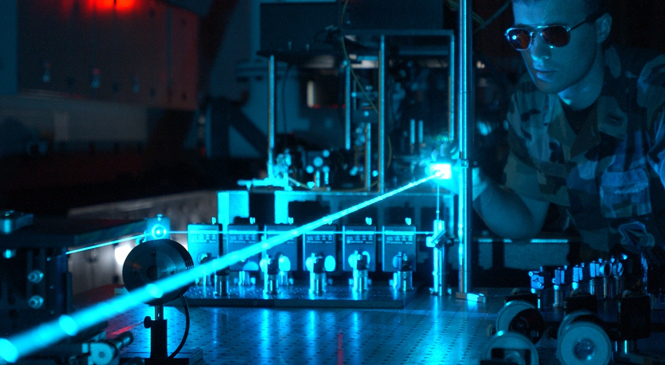Lasers, Lasers Everywhere

There is some recent buzz floating around about a laser weapon test by Lockheed Martin that burned through a truck engine from a mile away (here’s one). This particular device is rated at 30 kilowatts and reportedly took less than a minute to burn through the engine. Of course the truck was not moving and tilted at an angle for the test.
I’m not trying to demean the test in any way, this is a significant technological breakthrough. What is missing from all the articles that I scanned is even a simple explanation of what a laser is or how it works. We’ve been inundated with references to these devices in Science Fiction movies and books and they are used all over the place in the modern world. They are in CD, DVD, and Blu-Ray players as well as supermarket checkout scanners and those little laser pointers that drive cats nuts, but what are they? How do they work?
The word LASER is an acronym for “light amplification by stimulated emissions of radiation.” To gain an understanding of what that really means we have to delve a bit into the world of Quantum Mechanics. Fortunately, we only need to grasp a few fairly simple concepts to get an idea of what is going on. The first thing to get a handle on is the concept of a Photon. A photon is a packet of electromagnetic energy that vibrates. It has a frequency and acts like a wave traveling through space. There are two basic components of a wave, the wavelength and the amplitude:
The wavelength is the distance between peaks and the amplitude is the height. The frequency is related to the wavelength; it is a measure of how many peaks pass by in a unit amount of time. The energy of a photon is proportional to it wavelength. The color of the light is also relate to the wavelength. Red light is longer wavelengths and lower energy than violet light (ultraviolet is even higher energy, hence the sunburn). The amplitude of a wave is also proportional to its energy but with photons we generally don’t talk about the amplitude. The amplitude of all photons of the same wavelength have the same amplitude. We’ll see more about that in a bit.
One photon wave by itself is not all that interesting. We want to consider what happens when more than one are traveling in the same direction with the same wavelength or frequency. Let’s think about two waves traveling in the same direction so that they overlap, the technical term for this is superposition and two things can occur. They can be out of phase: the peaks do not line up or they can be in phase where the peaks do line up. In either case the principle of superposition states that the result is a new wave formed by adding the heights. When they are in phase the new wave is twice as high with twice as much energy. You should also realize that the case where the peaks and valleys line up the result is zero, the waves cancel each other out but it is the in phase condition that makes a laser work.
At this point we have a hint about the amplification part. We simply stack more and more photons of the same wavelength on top of each other all going the same direction in phase with each other. This state is classified as coherence. Conceptually, this seems simple enough but achieving a state of coherence with enough photons to make a useful beam requires some deeper Physics, so now we dive into the Quantum Mechanical world — but just a shallow dive so don’t be scared.
To start, let’s recall the simple model of an atom where electrons orbit around the nucleus like planets orbiting around the sun. Though this model is antiquated it helps get the basic ideas down. The rule of Quantum Mechanics to understand here is that the orbital levels that electrons reside in correspond to a particular energy levels and only discrete levels of energy are allowed. A simple way to think of that is that the energy levels are like floors in a building. An electron can be on any one of the floors but never in between floors. That is an odd notion, there are no stairs or elevators, the electrons jump from floor to floor without being anywhere in between. Energy has to be added to push an electron up a floor and energy is lost when an electron drops down a floor. In general, photons are what provides this energy transfer. A photon with the exact energy will be absorbed by an atom forcing the electron to the higher floor. A photon whose energy is the difference of the two levels is emitted when an electron drops down a level:
We can pump photons into a particular material to force electrons into the higher, excited state. Here’s the kicker. When a photon of the same energy as the drop between the levels passes close by an atom that has an electron in the higher, excited level the electron will drop to the lower level and the photon released will be going in the same direction in phase with the one that passed by. This is the “stimulated emissions of radiation” part. It should be obvious that a chain reaction can occur provided that we can pump enough energy into the system to keep the atoms returning to the excited state. It also helps to build a sort of resonance chamber with mirrors on either end; one end half-silvered to let a beam escape that is a integer multiple of the photon wavelength in length. This allows the photons to bounce back and forth gaining more energy on each pass. We do lose some of that energy recharging some of the atoms but, as long as we’re dumping more in from the outside, we will achieve a net gain and have a laser.
So there’s the short version. Any laser engineers in the crowd are most likely shaking their heads because this is a very simplified explanation, but the gist of it is correct. I’m not trying to tell you how to build one, just giving you an idea of how they work and now that I’ve done that let me answer the other questions popping up in your mind.
What is it about lasers that makes them so useful? Well maybe you’re not thinking that but I consider it a profound topic. Since their inception it has seemed to be a common goal to make lasers into the next generation of weaponry, but the reality is that they have become an extremely useful piece of equipment in many, many common devices. The reason being the precision that can be attained. A laser can emit a very narrow beam and, if you have been paying attention, the light is monochromatic, one very specific color because all the photons have the same frequency. This means that one can build a device that focuses on a very tiny area looking for a reflection and it is fairly easy to recognize when that reflection occurs since we just have to look for a specific color of light. This is the basic concept behind the Compact Disc player. A sequence of very tiny pits drilled into a reflective surface, when scanned by a laser, results in a sequence of on/off states – bits of memory.
Other laser devices often use the superposition principle that I described above. Again, simplifying for clarity, a laser beam is split using mirrors and the two beams take different paths. At some point in the mechanism the two beams are recombined and, if the length of the paths taken by the beams is different, they will be out of phase. The result will be adding and subtracting of the amplitudes that will display as a sequence of light and dark bands:
 Such a device is called an Interferometer as it measures the interference pattern of the two beams. These devices can make very precise distance measurements among other uses.
Such a device is called an Interferometer as it measures the interference pattern of the two beams. These devices can make very precise distance measurements among other uses.
So why are there not more laser weapons? This is an interesting question but the answer is fairly simple. The intensity of the laser beam dissipates as the distance increases. The beam spreads out as it travels and the wider the beam the lower the energy intensity. The further away the target lies, the more energy you have to pump into the beam. This makes it more difficult to design a usable weapon with any decent range. There are also issues with what is between you and the target. Even the air will increase the dissipation of the beam as the atoms and molecules will scatter some of the photons and larger particles like dust and smoke create even more problems. In fact, the only reason you might see a laser beam is due to scattering of photons by stuff in the air.
But Physicists and Engineers are clever people, many of these issues continue to be overcome.
So what have we learned?
- Photons make electrons jump.
- Lasers are everywhere but most of them are not so good at blowing things up.
- What’s a phaser?






